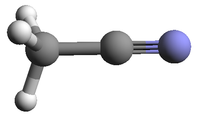|
This entry is a combined CDMS and JPL entry.
The latest combined fit has been reported by
(1) H. S. P. Müller; B. J. Drouin, and J. C. Pearson,
2009, Astron. Astrophys. 506, 1487.
This work provides new data between 338 and 1192 GHz.
Additional data were taken from
(2) J. C. Pearson and H. S. P. Müller,
1996, Astrophys. J. 471, 1067;
and from
(3) J. Demaison, A. Dubrulle, and D. Boucher,
1979, J. Mol. Spectrosc. 76, 1;
from
(4) A. Bauer,
1975, J. Mol. Spectrosc. 58, 111;
and from
(5) J. Haekel and H. Mäder,
1989, J. Quant. Spectrosc. Radiat. Transfer
41, 9.
The purely K-dependent terms A and
DK were assumed to agree with
those of the main isotopolog, see e041505.cat.
The predictions are probably reliable throughout.
Note:
Vibrational contributions have not been
considered in the calculation of the partition
function yet. Rough estimates may be obtained
by scaling the respective ground state value
with the ratio from the main isotopolog.
At low temperatures, it may be necessary to discern between
A-CH3C15N and
E-CH3C15N.
The A state levels are described by
K = 3n, those of E state
by K = 3n ± 1.
The nuclear spin-weight ratio is 2 : 1 for
A-CH3C15N with
K > 0 and all other states, respectively.
The JK = 11
level is the lowest E state level.
It is 5.5711 cm–1 above ground.
The dipole moment was reported by
(6) A. Mito, J. Sakai, and M. Katayama,
1984, J. Mol. Spectrosc. 103, 26.
|
